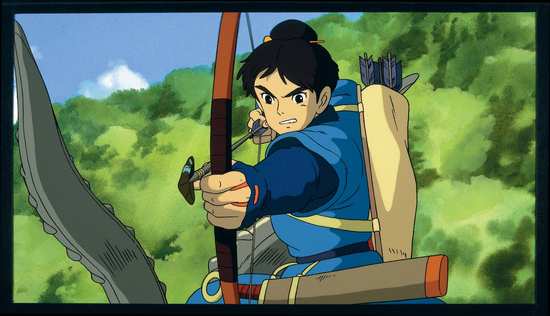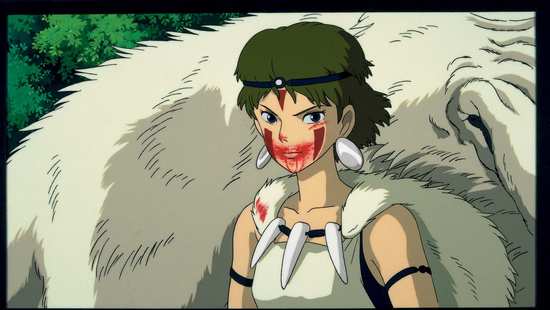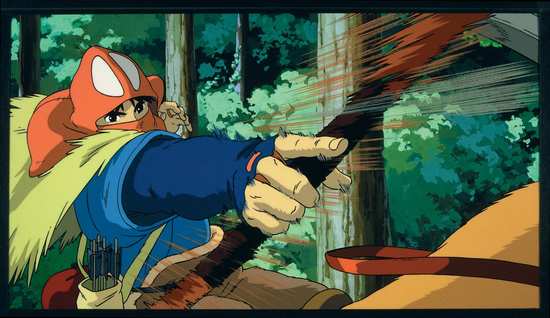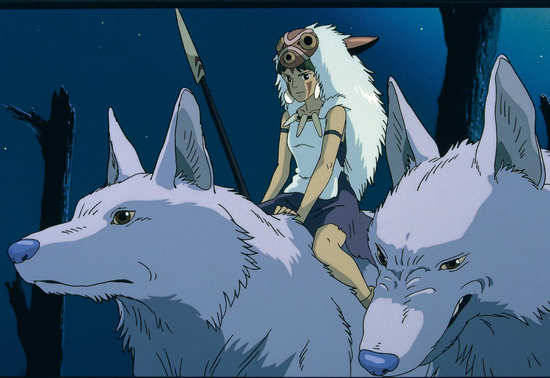Review for Princess Mononoke - Double Play: The Studio Ghibli Collection
Introduction
I remember ‘renting’ Princess Mononoke from Woolworths way back when it was originally released in the UK on the Disney label. As per Woolworths' policy at the time, they kept the cases on display, and the discs in card slipcases in a locked cupboard. To say the disc I received was scuffed and scratched is an understatement. That wasn’t why I returned it though; it was the original Disney release strategy for their Ghibli films in the UK, with dubtitled and barebones discs that put me off. Even back then, I knew I wanted my anime with translated subtitles at least. I never got around to getting the Optimum release that fixed those issues, although I have watched the film once or twice on FilmFour.
Just as Disney didn’t know what to do with Princess Mononoke in the UK, they had a similar problem in the US. They bought into the film expecting another Miyazaki fairy tale of the likes of My Neighbour Totoro and Kiki’s Delivery Service. What they got was a more adult oriented, character drama with an ecological message. What was at the time the most expensive anime film ever made, one of Japan’s box office smashes, turned out to be a box office flop in the US, as Disney and Miramax just didn’t know how to market it. But Princess Mononoke’s quality and importance survived those initial stumbles, and many consider it to be one of the best anime feature films ever made. I finally get to watch a home video release of this film, and I’m going straight for the Blu-ray. Princess Mononoke is being released as a Dual Play, collecting both the Blu-ray and DVD discs of this film. I’m reviewing just the Blu-ray component of this release.
A young warrior named Ashitaka takes defending his village very seriously, although defending it from a Forest God isn’t something a people that live attuned to nature would expect to do. This particular beast is afflicted by a curse brought on by a poison, a curse that gets transferred to Ashitaka when he comes into contact with it. His arm becomes corrupted, infected with a darkness that will eventually claim his life. He has no choice but to accept banishment from his home, and travel west to the home of the Forest Gods in the hope of finding a cure. What he finds is a land in turmoil, where a settlement under the control of Lady Eboshi is encroaching on the forest in their relentless desire for iron. This iron is used to make weapons, including primitive muskets, used in the conflict against the Forest Gods for their land. It’s one of these iron shells that initially cursed the Forest God that attacked Ashitaka’s village. But the other Forest Gods fighting back, although among them is a human girl, the Princess Mononoke. Ashitaka’s only chance to learn the truth of this, and hopefully find a cure, is to approach both sides with an open heart, but that might be something his cursed arm won’t allow.
Picture
Princess Mononoke gets a 1.85:1 widescreen transfer at 1080p resolution. The image is clear and sharp throughout, stable, and the Blu-ray format presents the film’s expressive colour palette to stunning effect. The character designs are typical for Ghibli, but the costume designs are exceptional and detailed, while the smooth and vivid animation looks astounding in HD. It’s the world design that really impresses, with Princess Mononoke’s clash of nature and civilisation depicted with a fascinating level of imagination. I find the Blu-ray transfer to be very agreeable, with the film retaining a light level of grain, but making the most of the detail and the clarity. When you compare it to the ‘raw’ footage in the trailers, you’ll see that like all of Madman’s transfers for Ghibli films, it’s gone through the post-processing of DNR to reduce the film grain, and for some that may not be as appealing. I think they find a reasonable compromise.
The images used in this review are sourced from the PR, and aren’t necessarily representative of the retail release.
Sound
You have the choice between DTS-HD MA 5.1 Surround English and Japanese, with an optional translated subtitle track to go with the Japanese audio. There is no signs only track on this release, although the opening text scroll gets a voiceover in the English dub. I went with the original language audio, and was happy enough with the experience. The dialogue comes across with clarity, and the film’s epic action sequences make their presence felt through the surround audio. Joe Hisaishi’s music also finds sufficient space, and there are no nits to pick with the audio experience. Lack of time meant that I didn’t sample the English audio, but like all of the Ghibli releases, it gets the A-list Hollywood treatment that other anime can only dream of, with luminaries like Claire Danes, Billy Crudup, Minnie Driver, Gillian Anderson, and Billy Bob Thornton in the cast. You can be assured that the English script (from Neil Gaiman), and the ADR process all had sufficient time and money to get it right.
Extras
For a premium Ghibli title on the scale of Princess Mononoke, the extras are somewhat disappointing. Even the smaller scale The Cat Returns gets more in the way of content.
The disc presents the film with an animated menu. And as per the Ghibli collection, you get Picture in Picture storyboards to go with the film.
The sole featurette is a 20-minute Princess Mononoke in the US piece, presented in 1080i, which follows director Hayao Miyazaki to Toronto, Los Angeles and New York as he promoted the film, back in 1999.
Other than that, all you get are variations on trailers, whether it’s a Promotional Video, Japanese Trailers, TV Spots, French and English trailers.
You also get trailers for My Neighbour Totoro, Ponyo, Howl’s Moving Castle, Nausicaa of the Valley of the Wind, Arrietty, and Porco Rosso.
Conclusion
Princess Mononoke has never really been one of my favourites of the Ghibli canon. The few times that I did watch it on television, I never really connected with it, and consequently when I came to watch it on Blu-ray for this review, I found that I could recall little about its characters or its story. In many ways watching this disc felt like watching the film for the first time. Alas, that didn’t mean that I suddenly found a new appreciation for it as a result. I do recognise it as a good film, and yes it may even be one of Ghibli’s greatest. What it does with its narrative, the quality of the writing, the depth of the characters and more importantly its subject matter, the messages that it conveys certainly elevate it above the more fantastic and fairy tale stories that people usually associate with Hayao Miyazaki. This is a thoughtful and deep film that invites further analysis and invokes debate. It’s also graphically violent in a way that gave Disney and Miramax such headaches when they originally distributed it in the late nineties.
For a film that sneaks over the 2 hour mark in runtime, it’s remarkably lean, paced efficiently and lacks padding. It throws you straight into the deep end with the attack on Ashitaka’s village, the corrupted form of the Forest God leaving its curse on Ashitaka when he kills it. We barely get to know his character or his home before he is banished, sent to find the Forest Gods and hopefully a cure too. We barely begin to know him before the curse begins to corrupt him, invoking an anger and rage when he fights that has a lethal effect. Once he is cursed, his aim is distorted when he uses a bow and arrow. He’s more than likely to maim and kill when he would rather warn and defend. As the curse spreads, so his rage becomes harder to control, and this makes approaching the problem with an open heart difficult.
It isn’t long before he finds the forest of the Deer God, and Lady Eboshi’s ironworks, and it’s here that the story really gets into gear, and Princess Mononoke’s message comes across. In a way it’s like a cross between an animated Lord of the Rings and Mad Max Beyond Thunderdome, if you can equate Lady Eboshi to a benevolent Aunt Entity, trying to forge civilisation from the ‘chaos’ of nature. It’s the encroachment of man on nature that causes the issues with the Forest Gods, razing the forest to get to resources, and setting up an industry that pollutes and contaminates is bound to have consequences. When nature is personified in the form of the Forest Gods, those consequences are immediate and devastating; with the obvious corruption of a manmade iron musket ball infecting and driving a Forest God mad.
The obvious villains aren’t any of the main characters either, with the whims of an unseen Emperor directing the action against the Forest Gods, the depredations of bandits fuelling the defensiveness of villagers and the demand for iron and iron weapons. San, the feral girl raised by the wolves that the ironworkers dub Princess Mononoke may have shunned humanity, considers herself a wolf, but she fights to defend her family and the forest. Some would consider Lady Eboshi to be the villain of the piece, after all she has created the ironworks, and is actively fighting the forest to expand her industry, but she is a benevolent and beloved ruler. She actively emancipates women slaves, brings them to the settlement, and gives them homes and jobs. She even welcomes lepers who have the talent to forge iron into muskets. She’s kind to her subjects, and has a warm sense of humour, but she needs the iron to defend her kingdom.
It makes it impossible for Ashitaka to choose sides, and he winds up walking a centre course that smacks of compromise in a situation where no compromise seems possible. Mononoke’s message is that human progress invariably leads to the destruction of nature, as pure an eco-message as you can imagine. It’s also notable in that even with the positive ending that the film manages to find, it’s stark that even with the most benevolent caretakers, the lightest touch on the environment, you may be able to preserve natural beauty and protect the ecology, but the very touch of man will change it from what it was, raw, verdant and fecund, into something that is a pale, managed, shadow of that.
What keeps me at a remove from this film is how it presents its story. I feel that Princess Mononoke is an adult and mature tale, but it doesn’t escape the legacy of Ghibli’s other output. You can see that this is still a film with a younger audience in mind, although certainly not the infant demographic. So I find the moments of violence curiously neutered and minimised, and lacking in consequence. Once Ashitaka is cursed, his bow become lethal, his arrows liable to decapitate and dismember their victims. But these deaths are curiously bloodless, the only significant blood that we see is when Ashitaka himself is shot, but the other victims of violence in the film, and there are plenty of battle scenes, are either shown at a distance, or as I say, don’t result in that much visible blood. The emotional effects of such violence are somewhat minimised, and that for me heightens the unreality of the story.
Princess Mononoke gets another splendid Blu-ray upgrade courtesy of Studiocanal, and you can see why this is one the most renowned entries in the Ghibli back catalogue. It’s well worth the upgrade to high definition.




Your Opinions and Comments
Be the first to post a comment!